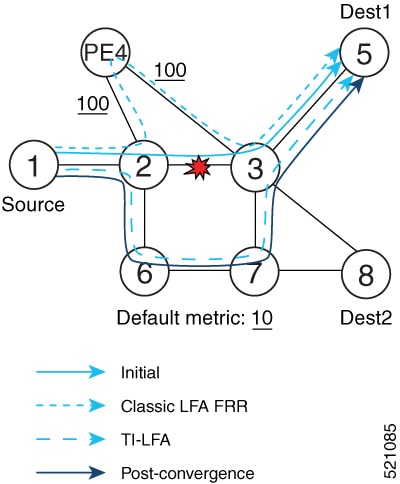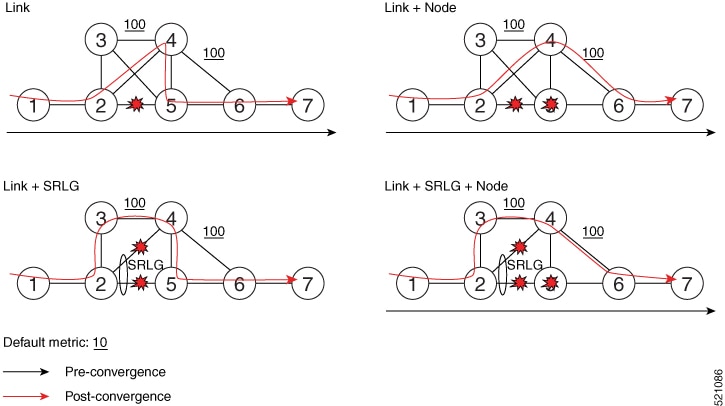Topology-Independent Loop-Free Alternates for SRv6
A Topology-Independent Loop-Free Alternate (TI-LFA) is a network protection mechanism for SRv6 deployments that:
-
provides link, node, and Shared Risk Link Groups (SRLG) protection
-
ensures rapid failure repair using pre-calculated optimal SRv6 backup paths, and
-
reduces packet loss during router convergence after a topology change.
Key concepts for SRv6 TI-LFA
-
Optimal Repair Path (Post-Convergence Path): This is the path that traffic will eventually follow after the Interior Gateway Protocol (IGP) has fully converged following a failure. SRv6 TI-LFA's pre-calculated backup paths are designed to be these optimal post-convergence paths, ensuring seamless transition and minimal traffic oscillation. This approach is preferred for capacity planning, operational simplicity and reduced traffic transitions.
-
TI-LFA protection types: SRv6 TI-LFA supports comprehensive protection against various failure modes:
-
Link protection: Excludes the failed link during backup path calculation.
-
Node protection: Excludes the neighbor node during backup path calculation.
-
-
Shared Risk Link Group (SRLG): A Shared Risk Link Group (SRLG) is a situation in a network where links share a common fiber or physical attribute, these links have a shared risk, and if one fails, others in the group might also fail
Benefits of TI-LFA
-
Overcoming traditional LFA limitations: SRv6 TI-LFA addresses the topology dependency and suboptimal path issues of classic LFA, and the incomplete coverage and operational complexity of remote LFA, providing robust protection where older methods fall short in SRv6 networks.
-
Maximized network uptime and availability: SRv6 TI-LFA's sub-50ms failure repair drastically reduces the duration of service interruptions and minimizes downtime, leading to near-instantaneous recovery. Its comprehensive protection against link, node, and SRLG failures ensures network-wide resilience in SRv6 infrastructures.
-
Reduced packet loss: By pre-calculating and immediately activating loop-free SRv6 backup paths, SRv6 TI-LFA ensures that traffic is quickly steered around failures, preventing packet drops during router convergence.
-
Optimized network performance: The SRv6 backup paths are pre-computed to align with the post-convergence path, meaning traffic is routed efficiently even during a failure, avoiding suboptimal detours. This leads to greater stability and less oscillation in the network, as traffic only shifts once.
-
Simplified network operations and management: SRv6 TI-LFA streamlines fast reroute configuration and management compared to older methods, reducing operational complexity. It automates best-path selection, eliminating the need for manual intervention or case-by-case adjustments in SRv6 networks.
-
Efficient resource utilization and capacity planning: Knowing that traffic will follow optimal paths even during failures allows for more accurate and efficient network capacity planning and resource allocation within SRv6 deployments.
Comparison with other Loop-Free Alternate (LFA) techniques for SRv6
The table below highlights the key differences between TI-LFA and other LFA techniques, specifically in the context of SRv6 deployments
|
Feature |
Classic Loop-Free Alternate (LFA) |
Remote LFA (RLFA |
Topology-Independent Loop-Free Alternate (TI-LFA) for SRv6 |
|---|---|---|---|
|
Topology dependency |
Topology dependent |
Extends coverage but remains topology dependent |
Topology independent |
|
Protection coverage |
Cannot protect all destinations in all networks. |
Extends coverage to 90-95% of destinations. |
Provides link, node, and SRLG protection in any SRv6 topology. |
|
Repair Path Optimality |
May not always provide the optimal LFA |
Does not always provide the most desired repair path. |
Provides optimal repair paths (post-convergence paths) using SRv6 SIDs |
|
Operational complexity |
Simpler, but limited coverage |
Adds operational complexity by requiring a targeted LDP session for LDP traffic |
Maintains the simplicity of the IPFRR solution within SRv6 |
|
Mechanism |
Relies on local topology for backup path calculation |
Uses tunnels (for example, LDP, GRE) to reach a remote LFA. |
Uses SRv6 Segment Identifiers (SIDs) to steer packets along a pre-calculated post-convergence path. |


 Feedback
Feedback